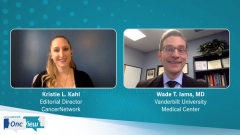
Chemotherapy in Small Cell Lung Cancer
Kristie L. Kahl: To start, can you discuss how chemotherapy has been a mainstay in small cell lung cancer treatment?
Wade T. Iams, MD: Small cell lung cancer is a rapidly growing cancer type. And in those circumstances, chemotherapy, which directly blocks cell growth of both cancer types and some normal cells, is particularly effective. The chemotherapy is able to shrink small cell lung cancer initially in a majority of patients. And it's a case where the aggressiveness of the cancer allows for standard chemotherapy types. Carboplatin or cisplatin and etoposide are the formal drug names that we typically use to be more effective in small cell lung cancer initially, compared to other cancer types.
Kristie L. Kahl: With this being a mainstay, are we ever going to shift away from chemotherapy? Or do you think this will always be a part of small cell lung cancer treatment?
Wade T. Iams, MD: I think that as part of the initial small cell lung cancer treatment, chemotherapy is a permanent fixture. And that's because it does, in most people, a good job of shrinking the cancer initially. I think there are interesting future questions within the field, whether chemotherapy will be used when small cell lung cancer recurs. In those circumstances, chemotherapy is much less effective. And small cell lung cancer treatment is very, very difficult after the initial shrinkage with chemotherapy, and in most individuals, unfortunately, small cell lung cancer does recur, and is very difficult to treat with chemotherapy at that point.
Kristie L. Kahl: How does small cell lung cancer react to treatment with chemo since it is a fast growing disease?
Wade T. Iams, MD: Small cell lung cancer typically shrinks with initial chemotherapy. Two out of 3 or more patients who are first diagnosed with small cell lung cancer have tumor shrinkage when they're treated with standard chemotherapy. If we're able to attempt to cure those individuals, we combine that with radiation is the most common strategy. And then we hope that when the small cell lung cancer is completely eradicated from their body, we know that because of the aggressiveness of small cell lung cancer, even when we're attempting to cure patients with both standard chemotherapy and radiation, more often than not, the cancer still comes back. And that may be because some of the cancer cells are resistant at the sites that we treated. Or it may be that there were cancer cells outside of the sites that we treated that we just didn't see on scans. And that's unfortunately a common phenomenon in all of cancer care: The reality that the scans are good, and they lay the groundwork for how we treat patients, but they're not a perfect measurement of cancer within a person's body.
Kristie L. Kahl: Similar to when we talked about the diagnosis, how does chemotherapy play a role when it comes to the multidisciplinary approach to small cell lung cancer?
Wade T. Iams, MD: Chemotherapy plays an integral role in being combined with radiation if we're treating an individual with a combination of chemotherapy and radiation, or after surgery. There are some, albeit rare, circumstances where a person with small cell lung cancer is eligible for surgery. So in the case of radiation, we would typically treat an individual with chemotherapy first, and then add radiation with that for subsequent rounds or cycles of chemotherapy for individuals treated with surgery with small cell lung cancer, those individuals go to surgery and then we treat them with chemotherapy after just in case there are cancer cells leftover.
Newsletter
Stay up to date on recent advances in the multidisciplinary approach to cancer.













































































